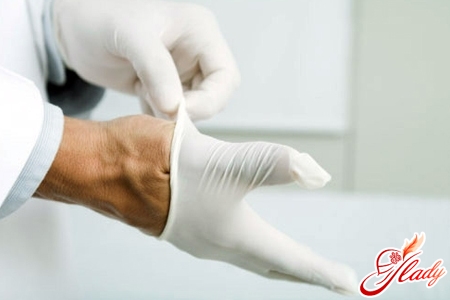 Vaginal discharge.Every woman of reproductive age, without exception, faces them every day. However, sometimes these discharges become a cause for concern for a woman. After all, if the discharge slightly changes in consistency, color or smell, the woman begins to panic, fearing that this indicates some kind of disease. And indeed, a change in the usual nature of vaginal discharge requires a consultation with a doctor - a gynecologist. After all, if a woman does not have a medical education, she will not be able to independently determine the cause of such vaginal discharge. Does the appearance of atypical discharge always indicate that a woman suffers from some kind of gynecological disease? Or is vaginal discharge a physiological norm? Readers will find answers to these questions in this article.
Vaginal discharge.Every woman of reproductive age, without exception, faces them every day. However, sometimes these discharges become a cause for concern for a woman. After all, if the discharge slightly changes in consistency, color or smell, the woman begins to panic, fearing that this indicates some kind of disease. And indeed, a change in the usual nature of vaginal discharge requires a consultation with a doctor - a gynecologist. After all, if a woman does not have a medical education, she will not be able to independently determine the cause of such vaginal discharge. Does the appearance of atypical discharge always indicate that a woman suffers from some kind of gynecological disease? Or is vaginal discharge a physiological norm? Readers will find answers to these questions in this article.
Normal vaginal discharge
Vaginal discharge does not always indicate that a woman suffers from any disease of the female reproductive system. A woman should not worry if she has:
- The vaginal discharge is transparent, resembling slime.
- The discharge does not have a pronounced odor.
- There are not many selections.
- Vaginal discharge does not cause irritation of the mucous membranes and skin of the genital organs.
- Vaginal discharge is not accompanied by an increase in body temperature, pain in the lower abdomen, or discomfort in the genital area - both external and internal.
In the event that the reproductive systemthe woman is in perfect order, her vaginal discharge is similar to mucus, which is produced by glands located on the cervix. Such discharge is a physiological norm, because it is with their help that the woman's genital tract is cleansed, thanks to which the woman is reliably protected from the penetration of certain pathogens into the genitals. The amount and consistency of normal vaginal discharge constantly varies, depending on the phase of the menstrual cycle, as well as on the general health of the woman. In addition, the individual characteristics of the female body in each specific case play a very important role. For example, liquid vaginal discharge is typical for the ovulation period, but after it, as a rule, the discharge becomes jelly-like. Sometimes the amount of vaginal discharge can increase sharply. As a rule, this happens in the following cases:
- A state of strong sexual arousal in a woman.
- Stressful condition.
- Chronic fatigue syndrome.
- Sharp change in climatic conditions.
In addition, very often a significant increasevaginal discharge is common in expectant mothers. Moreover, the longer the pregnancy, the more abundant the discharge. Such an increase in vaginal discharge during pregnancy has a simple and scientific explanation. This happens because during pregnancy, the content of sex hormones in the pregnant woman's body goes off the scale.
Other types of vaginal discharge
There are also other vaginal discharges,which can serve as a symptom of trouble in the female genital organs or even the presence of some diseases. This is what we will talk about below and what causes these vaginal discharge. As has already been said, if a woman is completely healthy, her discharge is watery or mucous, colorless, transparent and odorless. If there is a change in consistency, color, or acquires a specific odor, it can be assumed that there is some pathological process in the woman's body. Bloody vaginal discharge If there is blood in the vaginal discharge, it acquires a red tint. As a rule, such discharge appears in a woman about a few days before the onset of menstruation and smoothly flows into heavy menstrual flow. They can also persist for several days after the end of the menstrual cycle. Most often, this phenomenon is observed in those women who have a contraceptive coil. If these discharges are not very abundant, they are considered physiologically normal and do not require any treatment. Sometimes bloody discharge acquires a brown or even black tint, which is a consequence of oxidation and destruction of blood in the uterine cavity. Also, women sometimes experience systematic spotting bloody discharge that is not associated with the days of the menstrual cycle, or is associated, but the blood has a foul odor. All these cases require immediate consultation with a doctor, as they signal quite serious disorders. Also, the cause of mild bloody vaginal discharge can be the woman's intake of oral contraceptives. If such discharge occurs in the first two months of taking hormonal contraceptives, there is nothing to worry about. If bloody discharge continues in the third and fourth months of taking the drug, the woman should consult a doctor - a gynecologist as soon as possible. Most likely, this oral contraceptive is simply not suitable and needs to be replaced with another. In the same case, if a woman has heavy bloody discharge, in no way connected with the physiological cycle, this indicates the presence of a serious pathology. The woman should be examined by a gynecologist as soon as possible, because uterine bleeding is an extremely dangerous phenomenon for a woman's life. Losing time can result in very serious consequences for a woman's health and even a threat to her life. If the bloody discharge is not heavy, but nevertheless is also in no way connected with the menstrual cycle, it can also indicate such pathologies as:
- Violation of the menstrual cycle.
- The presence of endometriosis in a woman.
- Erosion of the cervix in neglected form.
- Cervical cancer. In this case, the strongest discharge occurs after sexual intercourse.
In the same case, if there is bloody dischargeoccur in a pregnant woman, she should immediately seek medical help. After all, in the early stages of pregnancy, bloody discharge can appear as a result of a spontaneous miscarriage, and in later stages - as a result of premature detachment of the placenta. In order to save the life of both the mother and the baby, the woman must be taken as quickly as possible to the nearest medical facility where there are doctors - gynecologists. Whitish and yellowish discharge If a woman has whitish or yellowish vaginal discharge, especially if it has a sharp unpleasant odor, there is every reason to believe that the woman has pathogens of sexually transmitted diseases in her body. Due to the huge number of leukocytes and microbes released, vaginal discharge acquires a whitish or yellowish tint. Such discharge is observed in women with diseases such as gonorrhea, trichomoniasis, chlamydia, thrush and others. Such discharge causes a woman a strong feeling of discomfort - itching, burning. In addition, many women complain of pain in the lower abdomen or in the lumbar region. The only case when such discharge is considered acceptable is pregnancy. If the expectant mother feels well, has no other complaints, and the test results are within the normal range, there is no reason to worry. Curdy, thick or foamy vaginal discharge We can also talk about pathology if a woman's vaginal discharge changes in consistency. If normal liquid vaginal discharge suddenly becomes foamy, or curdy, or excessively thick, the doctor may suspect that the woman has a particular disease of an infectious nature. Vaginal discharge with an unpleasant odor The same is true if a woman's vaginal discharge has acquired a sharp, specific unpleasant odor, this also indicates the presence of an infectious disease in the woman's body. The smell can be different - sour and rotten. The cause of the unpleasant smell is the waste products of pathogenic microflora - microorganisms feed and release a specific gas that has an extremely unpleasant smell. Vaginal discharge, as well as white, gray or greenish, appearing a few days or weeks after sexual contact is considered a signal of the occurrence of some infectious disease. Most often, sexually transmitted diseases occur. The most common include:
- Bacterial vaginitis.
- Urogenital trichomoniasis.
- Gonorrhea.
- Chlamydia.
It is absolutely unacceptable to ignorethe appearance of such vaginal discharge. After all, any disease, including sexually transmitted diseases, must be treated as early as possible. Otherwise, treatment will take much longer and require more effort. In addition, all sexually transmitted diseases can lead to serious complications, such as peritonitis, adhesions, secondary infertility, etc. However, self-medication is also not worth it, because in rare cases, such discharge can be caused by hormonal imbalance. And taking medications intended for the treatment of sexually transmitted diseases will put an extra burden on the body, and the true cause of such vaginal discharge will remain unknown. That is why, if a woman notices yellow vaginal discharge, she needs to see a doctor - a gynecologist as soon as possible. The doctor will examine the woman, take a gynecological smear. If necessary, a number of additional studies will be carried out to help identify a possible disease. And based on the results obtained, the doctor will prescribe adequate treatment that will lead to the woman's complete recovery. Vaginal discharge with a cheesy consistency If a woman notices cheesy discharge with a sour smell, most likely, we can talk about vaginal candidiasis. This disease is very common and is characterized by the following symptom. The mucous membranes of the external genitalia are covered with a whitish coating. This coating can be distributed evenly, or can be grouped in separate areas. If the disease is in an advanced form, the skin in the affected areas can crack. If you touch the affected areas of the skin, the woman experiences severe pain. In addition, one of the very first signs of thrush is severe itching in the perineum. This itching bothers sick women especially strongly at night. In addition, heat also significantly increases itching, for example, when taking a bath or a hot shower. Also, the most common process of urination brings extremely painful sensations to a woman - urine gets on the affected areas of the mucous membranes of the genitals and corrodes them. Getting rid of thrush is not so difficult - modern pharmacology offers women such drugs that eliminate thrush in just one day. And of course, treatment should be started as soon as possible. However, despite the fact that drugs for the treatment of thrush are sold without a doctor's prescription, you should not buy them on your own. Many of them have a number of contraindications, so only the attending physician should select the appropriate one. Therefore, if a woman notices white discharge from the vagina, she should seek medical help as soon as possible.
Discharge from the vagina during sexual intercourse
Female nature is such that at the moment whenженщина испытывает чувство сексуального возбуждения, ее влагалищные железы работают с утроенной силой, продуцируя огромное количество вагинальной смазки. Именно поэтому огромное количество вагинальных выделений как до, так и после полового контакта, является совершенно нормальным, и беспокоиться по этому поводу совершенно не стоит. Очень многие женщины замечают следующую закономерность. В том случае, если половой акт происходил без использования презерватива, после него всегда влагалищные выделения очень обильны. Это происходит из-за того, что организм подобным образом очищает влагалище от семенной жидкости. Беспокоиться по этому поводу не стоит – подобное явление пройдет очень быстро, примерно в течение часа. В том же случае, если у женщины после полового акта отмечаются кровянистые влагалищные выделения, это свидетельствует о том, что у нее, скорее всего, имеется эрозия шейки матки. Подобные выделения также исчезают достаточно быстро – буквально через несколько часов. Но после следующего же полового контакта снова возобновляются. Для их устранения необходимо обратиться к врачу – гинекологу для лечения эрозии шейки матки. Выделения в первом триместре беременности Разумеется, нельзя отдельно не рассказать о таком явлении, как влагалищные выделения у беременных женщин. Разумеется, все будущие мамы крайне трепетно относятся к своему здоровью, и влагалищные выделения также нередко становятся еще одним поводом для беспокойства. Обычные слизистые прозрачные выделения, не имеющие запаха и не вызывающие чувство дискомфорта в области половых органов, являются физиологической нормой и не должны беспокоить беременную женщину. А вот в том случае, если у беременной женщины появились кровянистые выделения, это является тревожным сигналом того, что в организме беременной женщины произошел какой-то сбой. Как правило, подобные выделения в первом триместре появляются в том случае, если начинается отторжение плодного яйца. Для того, чтобы избежать потери ребенка, беременная женщина должна быть как можно быстрее госпитализирована в гинекологическое отделение, где врачи предпримут все необходимые меры, чтобы сохранить беременность. Выделения на поздних сроках беременности У беременной женщины во втором триместре консистенция влагалищных выделений изменяется – они становятся более вязкими и густыми, чем раньше. Подобное явление считается физиологической нормой – таким образом организм женщины защищается от проникновения различных патогенных бактерий. Ведь любая инфекция способна причинить непоправимый вред здоровью будущего ребенка. А вот в том случае, если выделения из влагалища беременной женщины приобретут кровянистый оттенок, стоит насторожиться и как можно быстрее обратиться в медицинское учреждение. Ведь подобные выделения могут свидетельствовать о преждевременном начале родов, либо отслойке плаценты. В таком случае для того, чтобы спасти ребенка, нужна экстренная помощь врачей акушеров – гинекологов. Если же выделения не обильные, и имеют не красный, а коричневый оттенок, повода для особого беспокойства скорее всего нет. Очень часто подобные выделения появляются в результате слабого кровотечения из сосудов, расположенных на шейке сосудов матки. Однако, тем не менее, во время очередного планового посещения своего врача – гинеколога, беременная женщина обязательно должна поставить его в известность о подобных влагалищных выделениях. Советуем почитать:









